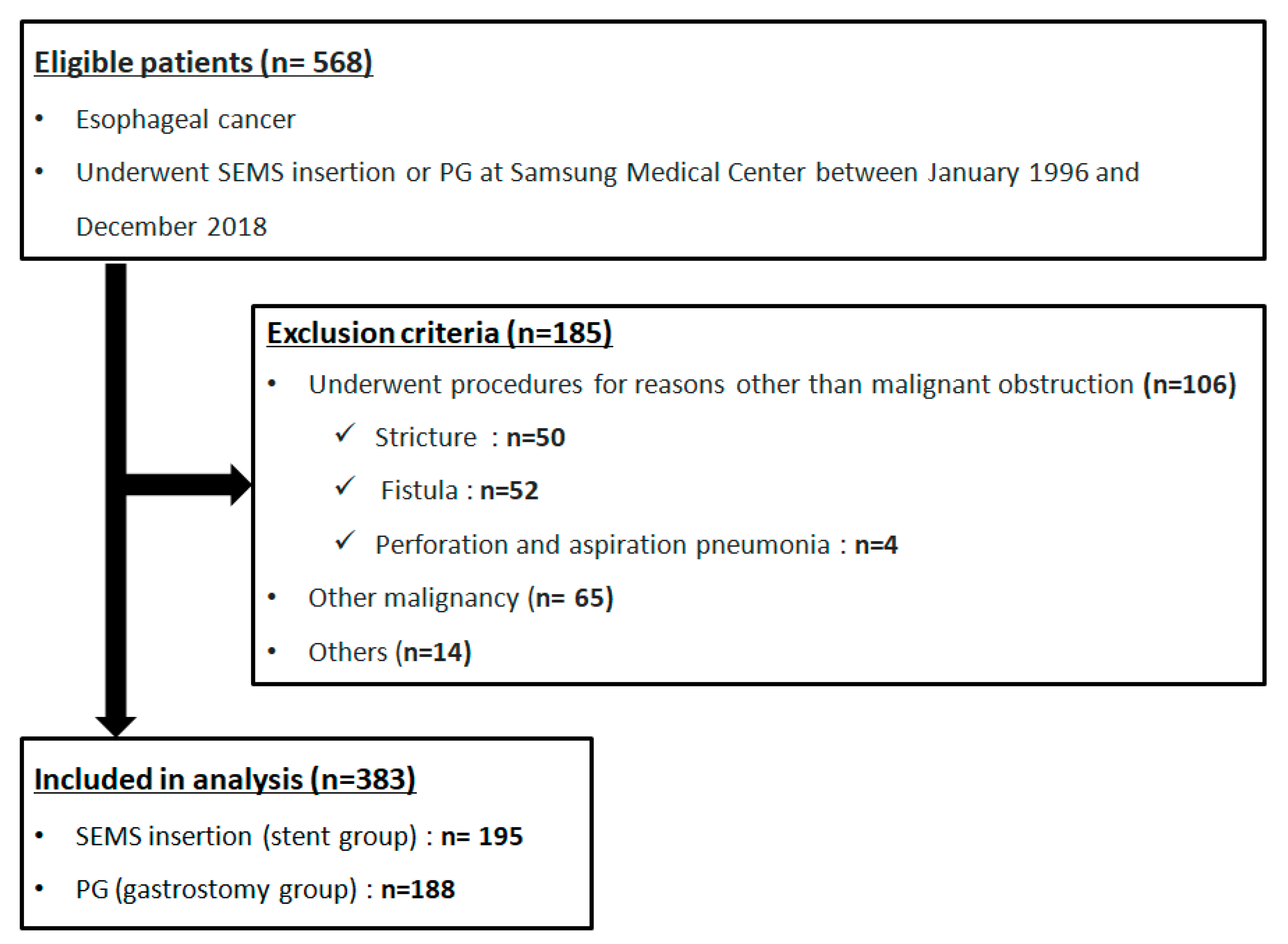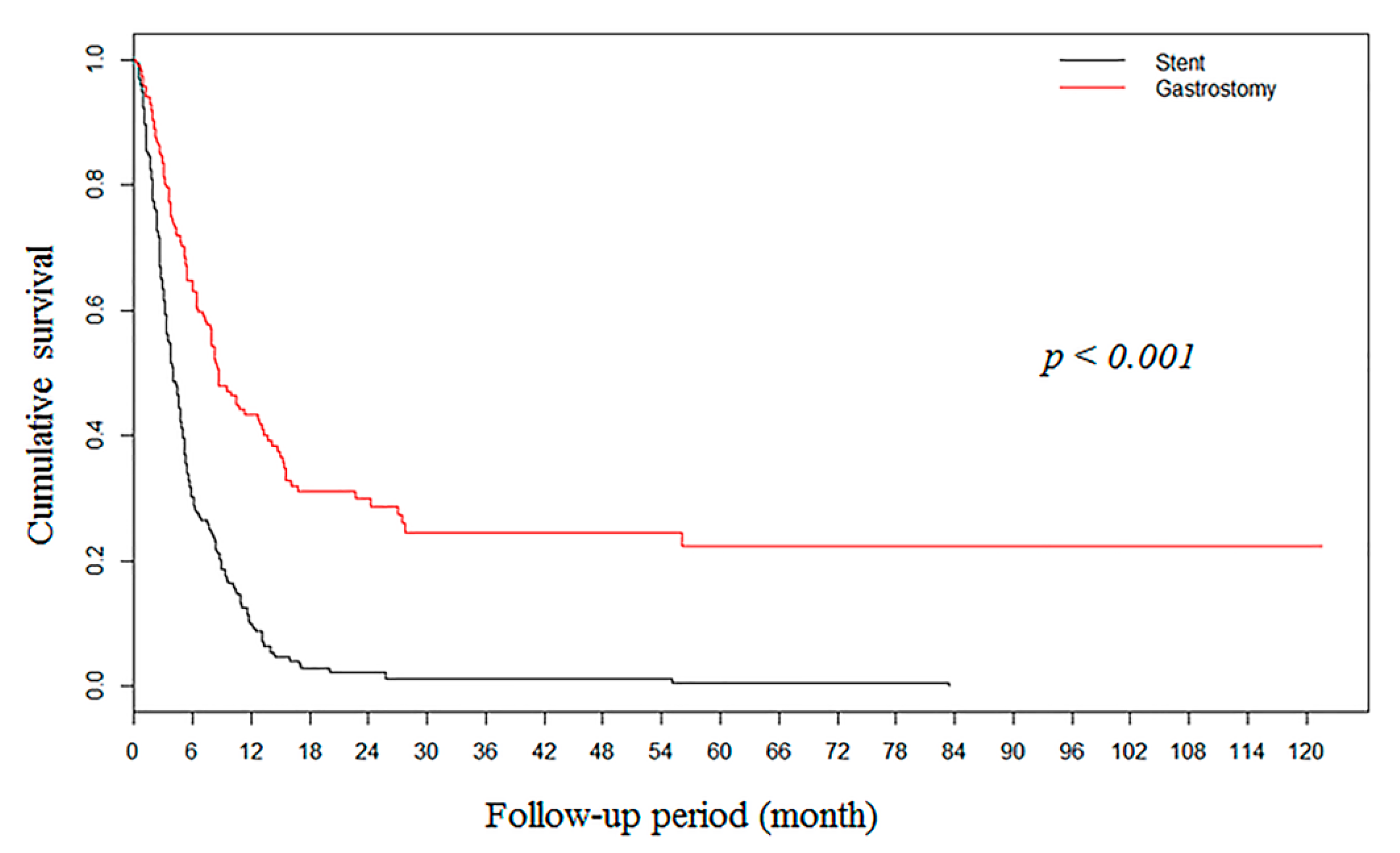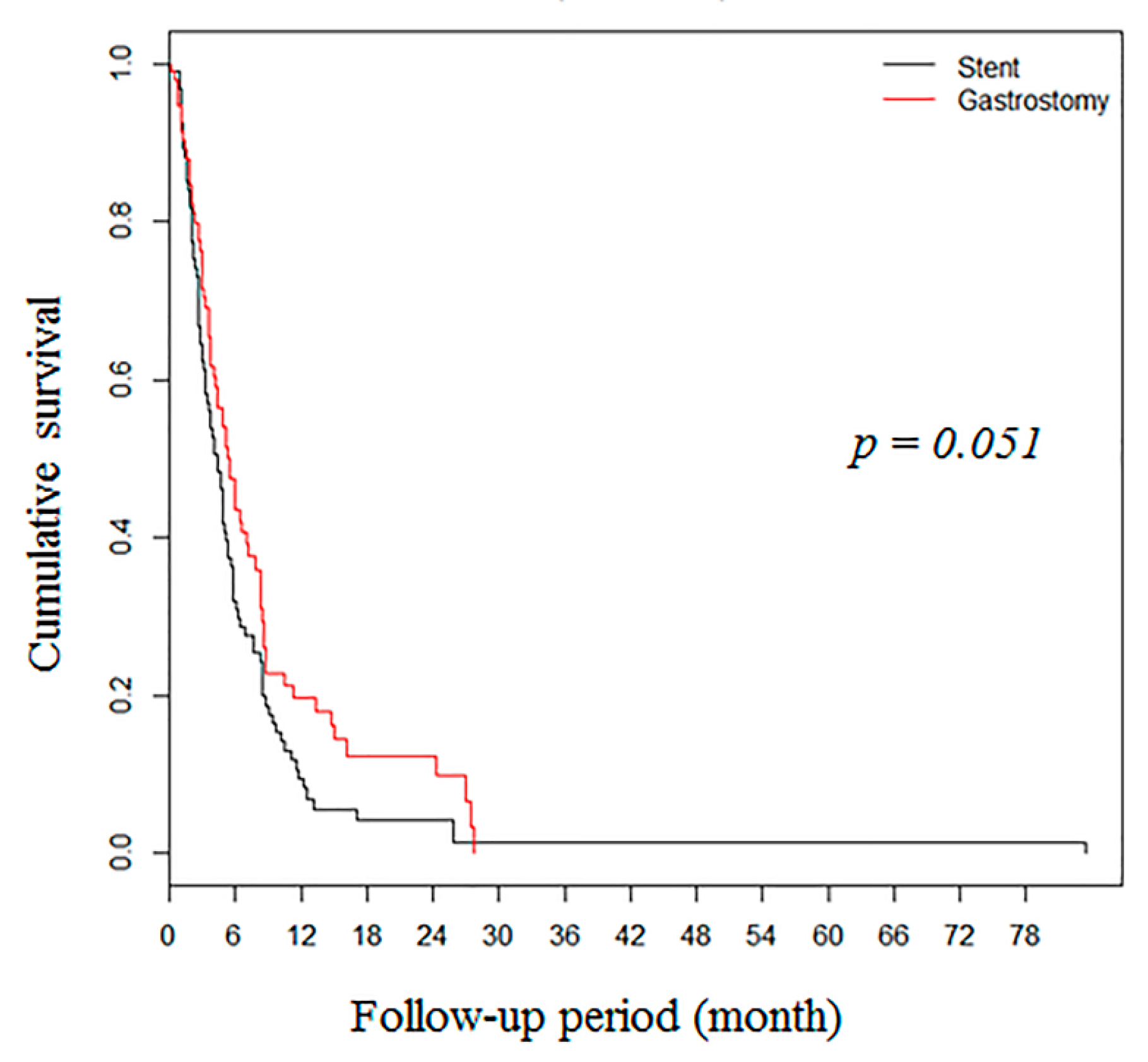Comparison between Percutaneous Gastrostomy and Self-Expandable Metal Stent Insertion for the Treatment of Malignant Esophageal Obstruction, after Propensity Score Matching
Abstract
1. Introduction
2. Materials and Methods
2.1. Study Population
2.2. Indication of Procedure
2.3. Outcome Measurement
2.4. Statistical Analysis
3. Results
3.1. Baseline Characteristics of the Study Population
3.2. Primary Outcomes of the Propensity Score-Matched Cohort
3.3. Overall Survival of the Study Population
3.4. Factors Associated with Overall Survival in Propensity Score-Matched Cohort
4. Discussion
5. Conclusions
Author Contributions
Funding
Acknowledgments
Conflicts of Interest
References
- Ferlay, J.; Steliarova-Foucher, E.; Lortet-Tieulent, J.; Rosso, S.; Coebergh, J.W.; Comber, H.; Forman, D.; Bray, F. Cancer incidence and mortality patterns in Europe: Estimates for 40 countries in 2012. Eur. J. Cancer 2013, 49, 1374–1403. [Google Scholar] [CrossRef]
- Bozzetti, F. Screening the nutritional status in oncology: A preliminary report on 1,000 outpatients. Support Care Cancer 2009, 17, 279–284. [Google Scholar] [CrossRef] [PubMed]
- Spaander, M.C.; Baron, T.H.; Siersema, P.D.; Fuccio, L.; Schumacher, B.; Escorsell, A.; Garcia-Pagan, J.C.; Dumonceau, J.M.; Conio, M.; de Ceglie, A.; et al. Esophageal stenting for benign and malignant disease: European Society of Gastrointestinal Endoscopy (ESGE) Clinical Guideline. Endoscopy 2016, 48, 939–948. [Google Scholar] [CrossRef] [PubMed]
- Nagaraja, V.; Cox, M.R.; Eslick, G.D. Safety and efficacy of esophageal stents preceding or during neoadjuvant chemotherapy for esophageal cancer: A systematic review and meta-analysis. J. Gastrointest. Oncol. 2014, 5, 119–126. [Google Scholar] [PubMed]
- Lopes, T.L.; Eloubeidi, M.A. A pilot study of fully covered self-expandable metal stents prior to neoadjuvant therapy for locally advanced esophageal cancer. Dis. Esophagus 2010, 23, 309–315. [Google Scholar] [CrossRef] [PubMed]
- Shenfine, J.; McNamee, P.; Steen, N.; Bond, J.; Griffin, S.M. A randomized controlled clinical trial of palliative therapies for patients with inoperable esophageal cancer. Am. J. Gastroenterol. 2009, 104, 1674–1685. [Google Scholar] [CrossRef] [PubMed]
- Senft, M.; Fietkau, R.; Iro, H.; Sailer, D.; Sauer, R. The influence of supportive nutritional therapy via percutaneous endoscopically guided gastrostomy on the quality of life of cancer patients. Support Care Cancer 1993, 1, 272–275. [Google Scholar] [CrossRef]
- Bower, M.R.; Martin, R.C., 2nd. Nutritional management during neoadjuvant therapy for esophageal cancer. J. Surg. Oncol. 2009, 100, 82–87. [Google Scholar] [CrossRef]
- Loser, C.; Aschl, G.; Hebuterne, X.; Mathus-Vliegen, E.M.; Muscaritoli, M.; Niv, Y.; Rollins, H.; Singer, P.; Skelly, R.H. ESPEN guidelines on artificial enteral nutrition--percutaneous endoscopic gastrostomy (PEG). Clin. Nutr. 2005, 24, 848–861. [Google Scholar]
- Sofue, K.; Takeuchi, Y.; Tsurusaki, M.; Shibamoto, K.; Sakamoto, N.; Kitajima, K.; Sone, M.; Sugimura, K.; Arai, Y. Value of percutaneous radiologic gastrostomy for patients with advanced esophageal cancer. Ann. Surg. Oncol. 2016, 23, 3623–3631. [Google Scholar] [CrossRef]
- Zuercher, B.F.; Grosjean, P.; Monnier, P. Percutaneous endoscopic gastrostomy in head and neck cancer patients: Indications, techniques, complications and results. Eur. Arch. Otorhinolaryngol. 2011, 268, 623–629. [Google Scholar] [CrossRef] [PubMed]
- Martin, R.C., 2nd; Cannon, R.M.; Brown, R.E.; Ellis, S.F.; Williams, S.; Scoggins, C.R.; Abbas, A.E. Evaluation of quality of life following placement of self-expanding plastic stents as a bridge to surgery in patients receiving neoadjuvant therapy for esophageal cancer. Oncologist 2014, 19, 259–265. [Google Scholar] [CrossRef] [PubMed]
- De la Mora Levy, J.G.; Manzano-Robleda, M.D.C. Nutrition before chemoradiotherapy or surgery: Temporary esophageal stents or tube feeding? Is the evidence hard to swallow? Gastrointest. Endosc. 2018, 88, 32–34. [Google Scholar] [CrossRef] [PubMed]
- Rice, T.W.; Blackstone, E.H.; Rusch, V.W. 7th edition of the AJCC cancer staging manual: Esophagus and esophagogastric junction. Ann. Surg. Oncol. 2010, 17, 1721–1724. [Google Scholar] [CrossRef]
- Ho, D.; Imai, K.; King, G.; Stuart, E.A. Matching as nonparametric preprocessing for reducing model dependence in parametric causal inference. Political Anal. 2007, 15, 199–236. [Google Scholar] [CrossRef]
- Stuart, E.A. Matching methods for causal inference: A review and a look forward. Stat. Sci. A Rev. J. Inst. Math. Stat. 2010, 25, 1. [Google Scholar] [CrossRef]
- Anandavadivelan, P.; Lagergren, P. Cachexia in patients with oesophageal cancer. Nat. Rev. Clin. Oncol. 2016, 13, 185–198. [Google Scholar] [CrossRef]
- Huddy, J.R.; Huddy, F.M.S.; Markar, S.R.; Tucker, O. Nutritional optimization during neoadjuvant therapy prior to surgical resection of esophageal cancer-a narrative review. Dis. Esophagus 2018, 31, 1–11. [Google Scholar] [CrossRef]
- Mariette, C.; Gronnier, C.; Duhamel, A.; Mabrut, J.Y.; Bail, J.P.; Carrere, N.; Lefevre, J.H.; Meunier, B.; Collet, D.; Piessen, G. Self-expanding covered metallic stent as a bridge to surgery in esophageal cancer: Impact on oncologic outcomes. J. Am. Coll. Surg. 2015, 220, 287–296. [Google Scholar] [CrossRef]
- Min, Y.W.; Jang, E.Y.; Jung, J.H.; Lee, H.; Min, B.H.; Lee, J.H.; Rhee, P.L.; Kim, J.J. Comparison between gastrostomy feeding and self-expandable metal stent insertion for patients with esophageal cancer and dysphagia. PLoS ONE 2017, 12, e0179522. [Google Scholar] [CrossRef]
- Yu, F.J.; Shih, H.Y.; Wu, C.Y.; Chuang, Y.S.; Lee, J.Y.; Li, H.P.; Fang, P.T.; Tsai, D.L.; Chou, S.H.; Wu, I.C. Enteral nutrition and quality of life in patients undergoing chemoradiotherapy for esophageal carcinoma: A comparison of nasogastric tube, esophageal stent, and ostomy tube feeding. Gastrointest. Endosc. 2018, 88, 21–31. [Google Scholar] [CrossRef] [PubMed]



| Gastrostomy Group (n = 188) | Stent Group (n = 195) | p-Value | ||
|---|---|---|---|---|
| Age | year | 63.80 ± 9.57 | 64.71 ± 10.36 | 0.37 |
| Gender | Male | 161 (85.6) | 180 (92.3) | 0.054 |
| Female | 27 (14.4) | 15 (7.7) | ||
| Stage | Stage II + III | 119 (63.3) | 33 (16.9) | <0.001 |
| Stage IV | 69 (36.7) | 162 (83.1) | ||
| Location | Cervical | 50 (26.6) | 5 (2.6) | <0.001 |
| Upper | 54 (28.7) | 37 (19.0) | ||
| Mid | 41 (21.8) | 68 (34.9) | ||
| Lower | 43 (22.9) | 85 (43.6) | ||
| Histology | Squamous cell carcinoma | 185 (98.4) | 181 (92.8) | 0.087 |
| Others | 3 (1.6) | 14 (7.2) | ||
| Length of obstruction | cm | 6.72 ± 3.17 | 6.53 ± 2.70 | 0.85 |
| Chemotherapy | None | 27 (14.4) | 49 (25.1) | <0.001 |
| Before procedure | 71 (37.8) | 100 (51.3) | ||
| After procedure | 90 (47.9) | 46 (23.6) | ||
| Radiotherapy | None | 46 (24.5) | 115 (59.0) | <0.001 |
| Before procedure | 60 (31.9) | 42 (21.5) | ||
| After procedure | 82 (43.6) | 38 (19.5) | ||
| Surgery | None | 130 (69.1) | 187 (95.9) | <0.001 |
| Before procedure | 1 (0.5) | 0 (0.0) | ||
| After procedure | 57 (30.3) | 8 (4.1) |
| Gastrostomy Group (n = 94) | Stent Group (n = 94) | SMD | ||
|---|---|---|---|---|
| Age | year | 64.67 ± 9.66 | 65.36 ± 10.05 | 0.070 |
| Gender | Male | 84 (89.4) | 86 (91.5) | 0.072 |
| Female | 10 (10.6) | 8 (8.5) | ||
| Stage | Stage II + III | 37 (39.4) | 33 (35.1) | 0.088 |
| Stage IV | 57 (60.6) | 61 (64.9) | ||
| Location | Cervical | 8 (8.5) | 5 (5.3) | −0.13 |
| Upper | 29 (30.9) | 28 (29.8) | −0.023 | |
| Mid | 28 (29.8) | 28 (29.8) | 0.00 | |
| Lower | 29 (30.9) | 33 (35.1) | 0.091 | |
| Histology | Squamous cell carcinoma | 92 (97.9) | 93 (98.9) | 0.085 |
| Others | 2 (2.1) | 1 (1.1) | ||
| Length of obstruction | cm | 7.06 ± 3.32 | 6.75 ± 2.93 | 0.098 |
| Chemotherapy | None | 20 (21.3) | 23 (24.5) | 0.076 |
| Before procedure | 42 (44.7) | 40 (42.6) | −0.043 | |
| After procedure | 32 (34.0) | 31 (33.0) | −0.023 | |
| Radiotherapy | None | 40 (42.6) | 42 (44.7) | 0.043 |
| Before procedure | 28 (29.8) | 29 (30.9) | 0.023 | |
| After procedure | 26 (27.7) | 23 (24.5) | −0.073 | |
| Surgery | None | 89 (94.7) | 88 (93.6) | −0.045 |
| Before procedure | 1 (1.1) | 0 (0.0) | −0.15 | |
| After procedure | 4 (4.3) | 6 (6.4) | 0.095 |
| Gastrostomy Group (n = 94) | Stent Group (n = 94) | p-Value | ||
|---|---|---|---|---|
| Weight change 1 | kg | −0.69 ±2.56 | −0.27 ± 3.48 | 0.58 |
| Albumin change 1 | g/dL | −0.15 ± 0.57 | −0.41 ± 0.59 | 0.021 |
| Additional intervention | None | 92 (97.9) | 72 (76.6) | <0.001 |
| Yes | 2 (2.1) | 22 (23.4) | ||
| Number of additional interventions | 0.04 ± 0.25 | 0.31 ± 0.61 | <0.001 | |
| Procedure-related complications | None | 90 (95.7) | 91 (96.8) | 1.00 |
| Yes | 4 (4.3) | 3 (3.2) | ||
| Aspiration pneumonia | None | 81 (86.2) | 81 (86.2) | 1.00 |
| Yes | 13 (13.8) | 13 (13.8) |
| Multivariable Analysis | |||
|---|---|---|---|
| HR (95% CI) | p-Value | ||
| Stage | Stage II + III | 1 | |
| Stage IV | 1.43 (1.00–2.06) | 0.052 | |
| Location | Cervical | 1 | 0.30 |
| Upper | 1.22 (0.64–2.34) | 0.54 | |
| Mid | 1.63 (0.84–3.16) | 0.15 | |
| Lower | 1.15 (0.59–2.23) | 0.69 | |
| Chemotherapy | None | 1 | 0.072 |
| Before procedure | 0.89 (0.57–1.39) | 0.62 | |
| After procedure | 0.60 (0.38–0.95) | 0.029 | |
| Radiotherapy | None | 1 | 0.031 |
| Before procedure | 1.55 (1.00–2.39) | 0.050 | |
| After procedure | 0.79 (0.51–1.22) | 0.29 | |
| Surgery | None | 1 | <0.001 |
| Before procedure | 123.08 (10.15–1492.60) | <0.001 | |
| After procedure | 0.34 (0.14–0.82) | 0.016 | |
| Type of procedure | Stent | 1 | |
| Gastrostomy | 0.69 (0.50–0.95) | 0.024 | |
© 2020 by the authors. Licensee MDPI, Basel, Switzerland. This article is an open access article distributed under the terms and conditions of the Creative Commons Attribution (CC BY) license (http://creativecommons.org/licenses/by/4.0/).
Share and Cite
Song, J.H.; Ko, J.; Min, Y.W.; Kim, K.; Lee, H.; Min, B.-H.; Lee, J.H.; Rhee, P.-L.; Kim, J.J. Comparison between Percutaneous Gastrostomy and Self-Expandable Metal Stent Insertion for the Treatment of Malignant Esophageal Obstruction, after Propensity Score Matching. Nutrients 2020, 12, 2756. https://doi.org/10.3390/nu12092756
Song JH, Ko J, Min YW, Kim K, Lee H, Min B-H, Lee JH, Rhee P-L, Kim JJ. Comparison between Percutaneous Gastrostomy and Self-Expandable Metal Stent Insertion for the Treatment of Malignant Esophageal Obstruction, after Propensity Score Matching. Nutrients. 2020; 12(9):2756. https://doi.org/10.3390/nu12092756
Chicago/Turabian StyleSong, Joo Hye, Jaehyun Ko, Yang Won Min, Kyunga Kim, Hyuk Lee, Byung-Hoon Min, Jun Haeng Lee, Poong-Lyul Rhee, and Jae J. Kim. 2020. "Comparison between Percutaneous Gastrostomy and Self-Expandable Metal Stent Insertion for the Treatment of Malignant Esophageal Obstruction, after Propensity Score Matching" Nutrients 12, no. 9: 2756. https://doi.org/10.3390/nu12092756
APA StyleSong, J. H., Ko, J., Min, Y. W., Kim, K., Lee, H., Min, B.-H., Lee, J. H., Rhee, P.-L., & Kim, J. J. (2020). Comparison between Percutaneous Gastrostomy and Self-Expandable Metal Stent Insertion for the Treatment of Malignant Esophageal Obstruction, after Propensity Score Matching. Nutrients, 12(9), 2756. https://doi.org/10.3390/nu12092756






